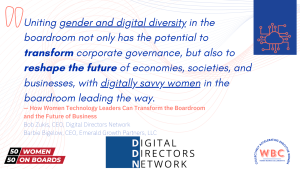
How Women Technology Leaders Can Transform the Boardroom and the Future of Business
May 4, 2022

Gender diversity in the boardroom is a global corporate governance advancement that has made long overdue progress. Studies have shown the far-reaching positive impacts of women’s boardroom leadership on the companies they govern.
This diversity is fostering higher levels of collaboration, creativity, and innovation. As the nature of work changes, though, and all organizations must rely on digital technologies to both operate and grow, board directors must understand the inherent risks at a systemic level.
The ability of corporate boards to govern digital and cyber risk has not increased meaningfully.
However, momentum is starting to grow in transforming global digital and cyber governance worldwide. Proposed Senate Bill S 808, The Cybersecurity Disclosure Act of 2021, would require U.S. public company boards to disclose cybersecurity experience or expertise in the boardroom. A similar disclosure standard was implemented in 2002 related to director financial expertise through the regulation known as Sarbanes-Oxley.
The MIT Sloan Center for Information Systems Research found companies with boardrooms that have a critical mass of at least three digitally savvy corporate directors have significantly better business results, including 38% higher revenue growth, 17% higher profitability, and 34% higher market capitalization growth. Digital leadership in the boardroom has a positive business impact, and so does boardroom gender diversity.
In addition to some boards augmenting their ranks with digital diversity, leading digitally savvy boards are forming technology and cybersecurity committees. They also understand, govern, and disclose more detail on the systemic cyber risks and the breadth and depth of threats facing their companies and business value creation.
The energy and focus on digital and cyber risk governance is starting to mirror the early stages of the movement to improve boardroom gender diversity. Combining these intensifying boardroom developments with the ongoing advancement of gender diversity can not only accelerate the need to significantly improve digital and cyber risk governance in boardrooms worldwide, but can also transform the future of business with digitally savvy women corporate directors leading the way.
IDC and the World Economic Forum project that over 60% of global GDP will be digitized by the end of 2022. People worldwide are experiencing digital transformation first-hand as the adoption of modern information and communication technologies (ICT) like the smartphone, have been far faster than prior advancements in similar consumer information technologies. Ongoing advancements with IoT, AI, and many other ICT technologies and applications will continue to prime the pump for disruption, while further anchoring our digital dependence.
As the promise and potential of the digital future continues to work through its growing pains, its dangers are on full display. Attackers freely exploit weaknesses in digital systems and capitalize on the far-reaching damages that they can inflict almost at will.
Attackers are growing more sophisticated and include nation-states and well-organized, resourceful, and persistent amateur and professional groups. Industry reports project that cybercrime will cost the global economy USD $10.5 trillion annually by 2025, making it the equivalent of the third-largest economy in the world, behind the U.S. and China.
These challenges demand a high level of attention in corporate boardrooms worldwide and present an opportunity for women technology leaders to step up to the challenge. Not only will this broaden the pool of women leaders who can contribute in the boardroom, it will deepen the skills and competencies of the boardroom in an urgent and critical area. Moreover, it will position women in the boardroom to lead on digital transformation and cyber risk oversight, two issues vital to the future of business.
The next chapter of business runs through complex digital business systems. Gender and broader boardroom representation will continue to improve worldwide. What better way to advance both issues and to increase influence, than to combine the two?
Uniting gender and digital diversity in the boardroom not only has the potential to transform corporate governance, but also to reshape the future of economies, societies, and businesses, with digitally savvy women in the boardroom leading the way.

